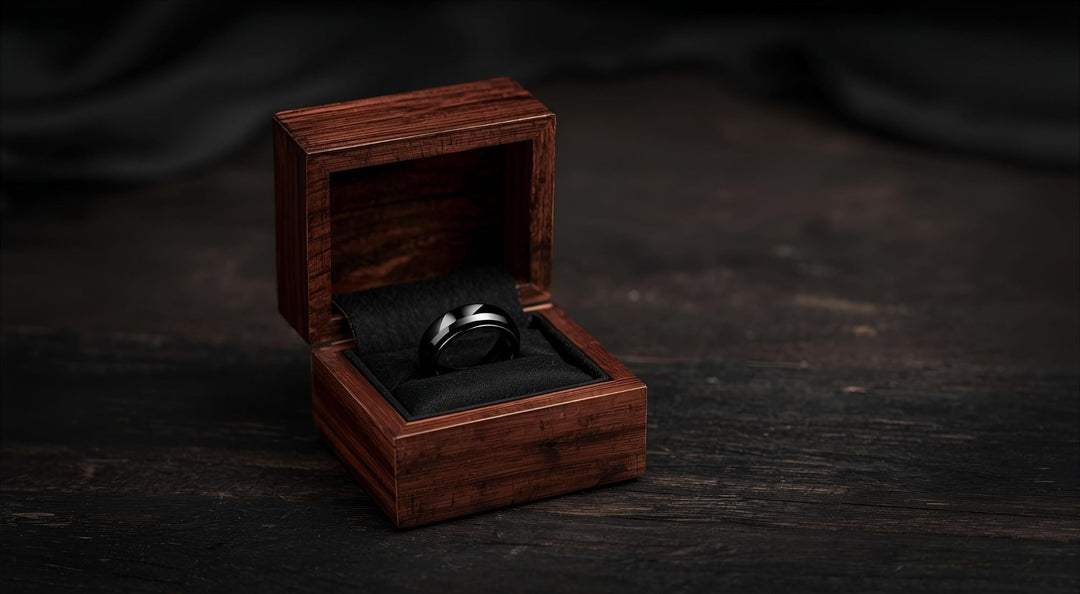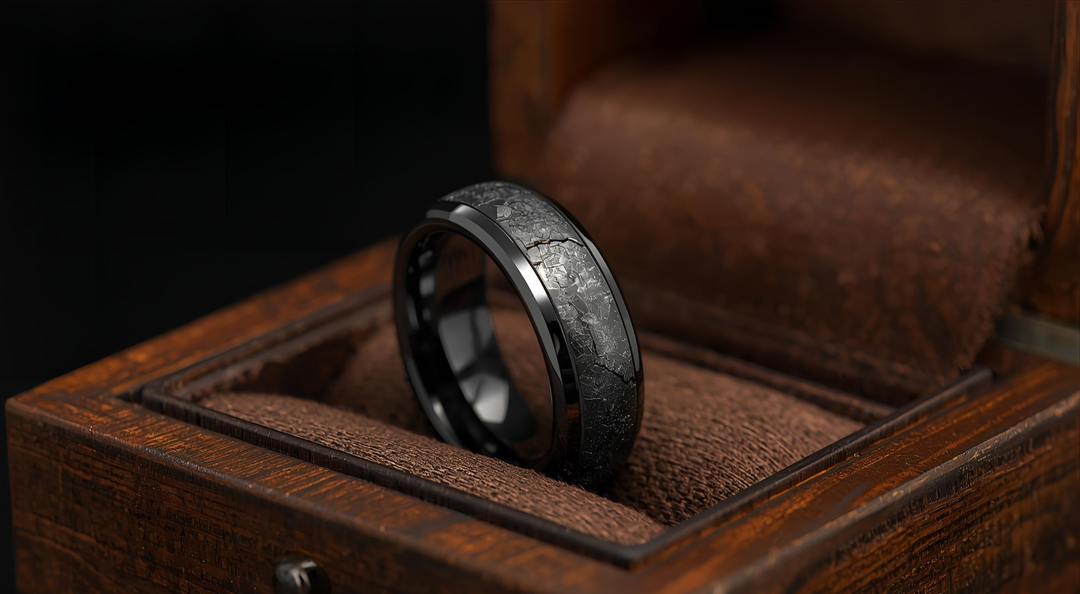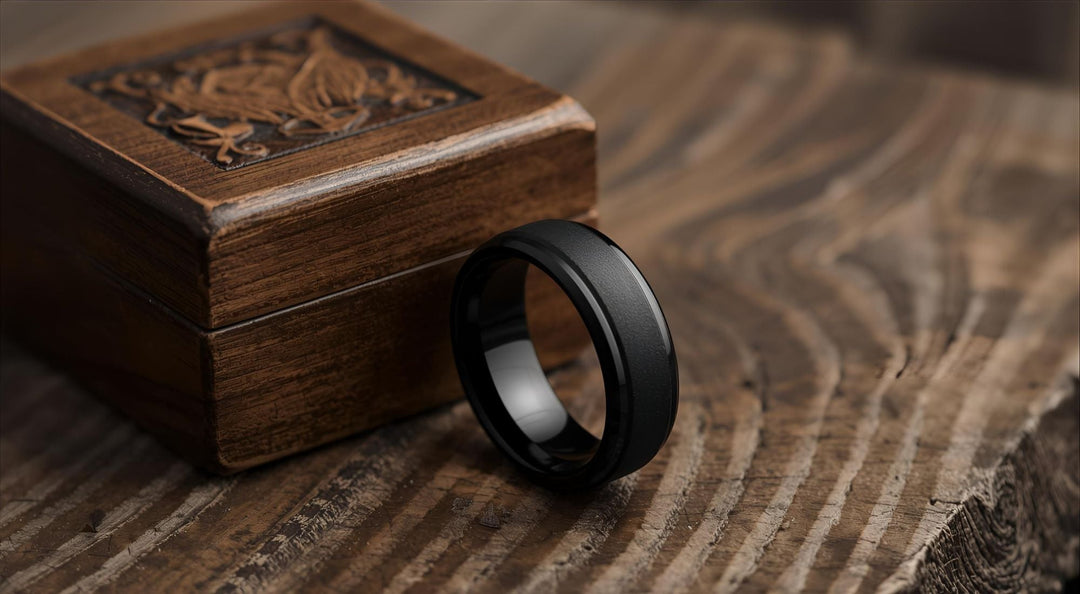🌌 Are Meteorite Rings Real? The Truth Behind These Cosmic Creations
Meteorite rings have become one of the most fascinating jewelry trends in recent years. Their mysterious origin and unique patterns make them more than just rings — they are literal fragments of space history. But many people wonder: are meteorite rings really made from space rocks? Let’s explore everything you need to know about authenticity, materials, and what makes a real meteorite ring so special.
1. What Are Meteorite Rings Made Of?
Real meteorite rings are typically made from iron meteorites, which consist mainly of iron and nickel, with small traces of cobalt and phosphorus. These space metals form distinctive crystalline structures known as Widmanstätten patterns, visible only after acid etching. These patterns cannot be replicated by any artificial process on Earth, which is why genuine meteorite rings have a unique fingerprint that sets them apart from imitation designs.
Over millions of years in space, these metals cooled slowly, creating intricate geometric lines that symbolize cosmic order. Because of their iron content, meteorite rings must be sealed or maintained carefully to prevent rust. Some jewelers blend the meteorite with titanium, tungsten, or gold to increase durability and protect against oxidation — without losing the natural extraterrestrial aesthetic.
✨ Discover the Uniqueness of Real Meteorite Rings
Every meteorite ring tells a story older than Earth itself — a story forged in the heart of a distant star. If the idea of wearing a piece of the cosmos inspires you, explore our exclusive collection of authentic Meteorite Rings crafted with precision and timeless style.
👉 Explore the Meteorite Rings Collection
2. How Can You Tell if a Meteorite Ring Is Real or Fake?

Authentic meteorite rings have natural irregular patterns and a slightly textured feel. If a ring looks too smooth or perfectly uniform, it’s likely fake.
Real meteorite displays the Widmanstätten pattern — a cross-hatched design created during millions of years of slow cooling in outer space. Fake ones are often made of stainless steel etched with acid to mimic the look. You can also test with a magnet: genuine meteorite is magnetic due to its iron content. Additionally, a professional jeweler can verify authenticity using microscopic analysis or certificate documentation from the meteorite’s source.
3. Are All Meteorite Rings Made from Real Space Rocks?
Not all rings labeled “meteorite” contain genuine space metal.
Many mass-produced “meteorite-style” rings are made from etched steel, meteorite dust, or replica composites. While these may look similar, they lack the authenticity, energy, and unique cosmic structure of a real meteorite. True meteorite rings come from recovered fragments that fell to Earth thousands of years ago, carefully cut and shaped by expert jewelers. When buying, always ask for details about the type of meteorite and its origin to ensure authenticity.
4. What Types of Meteorites Are Used in Rings?

The most popular meteorites used in jewelry are Gibeon (Namibia), Muonionalusta (Sweden), Seymchan (Russia), and Campo del Cielo (Argentina).
Each has distinct patterns and colors: Gibeon is fine-grained with elegant symmetry; Muonionalusta shows striking silver-gray contrast; Campo del Cielo has a darker, rugged texture. Jewelers select these types for their stability and visual appeal. Because each fragment is unique, no two meteorite rings ever look the same — making them deeply personal and one-of-a-kind.
5. Why Are Meteorite Rings So Expensive?
Authenticity, rarity, and craftsmanship explain the price. A real meteorite ring is made from material older than Earth itself — often over 4 billion years old. Extracting, cutting, and stabilizing the metal requires specialized skill to avoid damaging the Widmanstätten pattern. Add the rarity of legal meteorite sources, and it’s easy to understand why these rings are priced higher than standard metal jewelry. When you buy one, you’re not just paying for a ring — you’re investing in a literal piece of the cosmos.
6. Are Meteorite Rings Certified or Authenticated?
Yes — reputable jewelers provide a certificate of authenticity.
This document states the meteorite’s name (e.g., Gibeon or Muonionalusta), origin, and scientific classification. Many meteorite dealers are registered with international databases to ensure the fragments come from verified sources. Avoid buying from vendors who cannot provide documentation. A certificate adds value and peace of mind, proving your ring contains real extraterrestrial material and not imitation steel.
7. Are Meteorite Rings Durable?

Meteorite is strong but not indestructible.Because it contains iron, it can rust if exposed to moisture. Most jewelers seal the metal with a protective wax or resin layer to prevent corrosion. With proper care — regular cleaning and keeping it dry — a meteorite ring can last for decades. When combined with durable metals like titanium or tungsten, it becomes both beautiful and resilient enough for everyday wear.
8. Are Meteorite Rings Safe to Wear?
Yes, real meteorite rings are generally safe to wear. Most meteorites are composed of iron and nickel, which are non-toxic. However, individuals with severe nickel allergies should opt for rings that have been sealed or lined with hypoallergenic materials like gold, titanium, or tungsten. These layers prevent direct skin contact and eliminate any risk of irritation. If the ring is properly coated and well maintained, it poses no health risk.
9. Where Do Real Meteorite Rings Come From?

Real meteorites are found all over the world — from Namibia to Sweden and Argentina.
These ancient space fragments landed on Earth thousands of years ago and were later discovered by scientists or explorers. Each meteorite has its own story — its journey through space, entry into the atmosphere, and discovery site. Reputable jewelers source fragments legally from trusted suppliers, ensuring each ring carries a traceable origin and genuine cosmic history.
10. What Makes a Meteorite Ring Unique Compared to Regular Rings?
A meteorite ring is not just jewelry — it’s a symbol of eternity. Unlike gold or silver, each meteorite ring has a natural pattern formed in outer space, making it impossible to duplicate. Its ancient age and cosmic origin give it deep symbolic meaning: endurance, timelessness, and the infinite beauty of the universe. Wearing one is like carrying a piece of the stars — a daily reminder of how vast and extraordinary our existence truly is.
🌠 Final Thoughts
So, are meteorite rings real? Yes — when purchased from verified sources, they are authentic fragments of space history transformed into wearable art. Their natural beauty, rarity, and symbolism make them far more than an accessory — they’re a story of the universe, captured in metal and time.
Now that you understand what makes meteorite rings authentic, take the next step and learn how to maintain them like a pro:
- 🔹 Do Meteorite Rings Rust? — Understand how oxidation affects real meteorite.
- 🔹 How to Care for a Meteorite Ring — Simple steps to keep your ring shining for life.
Keep your piece of the universe looking as timeless as the stars it came from.






Leave a comment